Spatial Variability of Yield and Nitrogen Indicators—A Crop Rotation Approach
Abstract
1. Introduction
2. Materials and Methods
2.1. Site Description
2.2. Agronomic Operations
2.3. Collection of Study Materials and Chemical Analyses
2.4. Calculated Plant and Soil Nitrogen Indices
- Plant and nutrient indices
1. Total nitrogen TN = Na + Nr (kg ha−1) (1) 2. Nitrogen harvest index NHI = Na/TN (%) (2) 3. Unit nitrogen accumulation UNA = Nse/Y (kg N t−1 seeds) (3) 4. Unit nitrogen productivity UNP = Y/Nse (kg seeds kg Nse) (4) - Soil nitrogen parameters
where: Y—seed yield, seed yield, t ha−1 or kg ha−1; TN—total N uptake, kg ha−1; Na, Nr—amount of N in seeds/grain, and harvest residues at BBCH 89, kg ha−1, respectively; Nmin—the amount of mineral N at the WOSR spring regrowth, kg ha−1; Nminr—the amount of mineral N after WOSR harvest, kg ha−1. Nf—N fertilizer rate, kg ha−1; TN—total amount of N in WOSR at harvest.1. N input Nin = Nmin + Nf (kg ha−1) (5) 2. Mineral N balance Nb = Nin − TN (kg ha−1) (6) 3. Net N gain Ngain = Nminr − Nb (kg ha−1) (7) 4. Total N input Nint = Nin + Ngain (kg ha−1) (8) 5. Nitrogen input efficiency NEin = Nse/Nin × 100% (9) 6. Total N input efficiency NEint = Nse/Nint × 100% (10) - Yield gap, (YG) and nitrogen gap (NG) calculationThe following set of equations was applied to calculate both indices:
where PFPNin (kg CUs kg−1 N) is the unit nitrogen productivity as a function of total nitrogen input in the system at the onset of spring vegetation (Nin) and the actual yield (Y; kg CUs). To delineate the role of PFPNin on yield, the critical value of PFPNin was defined. In this study, the critical PFPNin (cPFPNin) was calculated as the average of the third quartile (Q3) of PFPNin values measured for each crop in the studied year. To determine the cPFPNin, the calculated PFPNin values were ranked in ascending order. The third quartile comprises values above the 75th percentile, i.e., representing 12.5% observations with the highest PFPNin values. The cPFPNin is the average of the PFPNin values lying between the 75th percentile and the highest value of the considered data set.1. Partial factor productivity of Nin PFPNin = Y/Nin (kg seeds kg−1 NNin) (11) 2. Maximum attainable yield Yatt = cPFPNin·Nin (t, kg ha−1) (12) 3. Yield gap YG = Yatt − Y (13) 4. Nitrogen gap NG = YG/cPFPNin (14)
2.5. Statistical Analyses
3. Results
3.1. Winter Oilseed Rape—Crop N Indicators
3.2. Winter Oilseed Rape—Soil N Indicators
3.3. Spatial Distribution of Yield and N Management Indicators
3.4. Winter Triticale—Crop N Indicators
3.5. Winter Triticale—Soil N Indicators
3.6. Spatial Distribution of Yield and N Management Indicators—WTR
4. Discussion
4.1. Yield—A Diagnostic Based on Crop Nitrogen Indicators
4.2. Nitrogen Gap
4.3. Yield—A Diagnostic Based on Soil Nitrogen Indicators
| 1. WOSR: | Y = −0.025Nb + 7.690 for n = 55, R2 = 0.85, and p ≤ 0.001 | (22) |
| 2. WTR: | Y = −0.031Nb + 7.005 for n = 52, R2 = 0.62, and p ≤ 0.001 | (23) |
| 1. WOSR: | Ygain = −1.003Nb + 79.9 for n = 55, R2 = 0.88, and p ≤ 0.001 | (24) |
| 2. Triticale: | Ygain = −0.794Nb + 85.9 for n = 52, R2 = 0.55, and p ≤ 0.001 | (25) |
5. Conclusions
Supplementary Materials
Author Contributions
Funding
Conflicts of Interest
Appendix A
| Variables | PC1 | PC2 | PC3 |
|---|---|---|---|
| Yield, Y-OSR-CU 1, t ha−1 | 0.97 4 | 0.11 | 0.02 |
| Seed N, Na, kg ha−1 | 0.91 | 0.38 | 0.04 |
| Residual N (Nr), kg ha−1 | 0.87 | 0.29 | −0.38 |
| Total N uptake, TN, kg ha−1 | 0.92 | 0.35 | −0.15 |
| N harvest index,% | 0.12 | 0.20 | 0.92 |
| Unit N accumulation, UNA, kg Na t−1 seeds | −0.28 | 0.90 | 0.11 |
| Unit N productivity, UNP, kg seeds kg−1 Na | 0.28 | −0.90 | −0.08 |
| PFPNin 2, kg seed kg−1 Nin 3 | 0.94 | −0.11 | 0.10 |
| Y attainable, Yatt, t ha−1 | −0.39 | 0.56 | −0.29 |
| Yield gap, YG, t ha−1 | 0.92 | −0.26 | 0.16 |
| Variables | PC1 | PC2 | PC3 |
|---|---|---|---|
| Yield, Y-CU 1, t ha−1 | −0.95 | 0.20 | 0.14 |
| N input at spring, Nin kg ha−1 | 0.40 | 0.39 | 0.83 |
| Mineral N after harvest, Nminr, kg ha−1 | −0.01 | −0.96 | 0.26 |
| N balance, Nb, kg ha−1 | 0.99 | 0.01 | 0.02 |
| In-season mineralized N, Ngain, kg ha−1; | −0.93 | −0.35 | 0.08 |
| Total N input, NinT, kg ha−1 | −0.89 | −0.24 | 0.39 |
| Efficiency of N input, NEin,% | −0.99 | 0.03 | 0.03 |
| Efficiency of total N input, NEinT,% | −0.55 | 0.81 | 0.04 |
| Nitrogen gap, NG, kg ha−1 | −0.94 | 0.05 | −0.28 |
| Variables | PC1 | PC2 |
|---|---|---|
| Yield, Y-CU 1, T ha−1 | 0.97 4 | −0.19 |
| Seed N, Na, kg ha−1 | 0.91 | −0.38 |
| Residual N (Nr), kg ha−1 | 0.53 | −0.67 |
| Total N uptake, TN. kg ha−1 | 0.89 | −0.45 |
| N harvest index,% | 0.66 | 0.20 |
| Unit N accumulation, UNA, kg Na t−1 seeds | −0.50 | −0.74 |
| Unit N productivity, UNP, kg seeds kg−1 Na | 0.46 | 0.77 |
| PFPNin2, kg seed kg−1 Nin 3 | 0.97 | 0.11 |
| Y attainable, Yatt, t ha−1 | −0.11 | −0.72 |
| Yield gap, YG, t ha−1 | 0.92 | 0.25 |
| Variables | PC1 | PC2 | PC3 |
|---|---|---|---|
| Yield, Y-CU 1, t ha−1 | −0.91 | −0.03 | 0.37 |
| N input at spring, Nin kg ha−1 | 0.26 | −0.31 | 0.91 |
| Mineral N after harvest, Nminr, kg ha−1 | 0.22 | −0.96 | −0.15 |
| N balance, Nb, kg ha−1 | 0.97 | −0.09 | 0.21 |
| In-season mineralized N, Ngain, kg ha−1 | −0.75 | −0.59 | −0.30 |
| Total N input, NinT, kg ha−1 | −0.57 | −0.77 | 0.27 |
| Efficiency of N input, NEin,% | −0.99 | 0.00 | 0.02 |
| Efficiency of total N input, NEinT,% | −0.71 | 0.53 | 0.44 |
| Nitrogen gap, NG, kg ha−1 | −0.95 | 0.15 | −0.20 |
References
- Sinclair, T.R.; Rufty, T.W. Nitrogen and water resources commonly limit crop yield increases, not necessarily plant genetics. Glob. Food Secur. 2012, 1, 94–98. [Google Scholar] [CrossRef]
- Ray, D.K.; Mueller, N.D.; West, P.C.; Foley, J.A. Yield trends are insufficient to double global crop production by 2050. PLoS ONE 2013, 8, e66428. [Google Scholar] [CrossRef] [PubMed]
- Billen, G.; Lassaletta, L.; Garnier, J. A biochemical view oft he global agro-food system: Nitrogen flows associated with protein production, consumption and trade. Glob. Food Secur. 2014, 3, 209–219. [Google Scholar] [CrossRef]
- Fisher, R.A.; Edmeades, G.O. Breeding and cereal yield progress. Crop Sci. 2010, 50, S-85–S-98. [Google Scholar] [CrossRef]
- Parry, M.A.J.; Hawkesford, M.J. An integrated approach to crop genetic improvement. J. Integr. Plant Biol. 2012, 54, 250–259. [Google Scholar] [CrossRef] [PubMed]
- Lassaletta, L.; Billen, G.; Garnier, J.; Bouwman, L.; Velazquez, E.; Muleller, N.D.; Gerber, J.S. Nitrogen use in the global system: Past trends and future trajectories of agronomic performance, pollution, trade, and dietary demand. Environ. Res. Lett. 2016, 11, 095007. [Google Scholar] [CrossRef]
- Taiz, L. Agriculture, plant physiology, and human population growth: Past, present, and future. Theor. Exp. Plant Physiol. 2013, 25, 167–181. [Google Scholar] [CrossRef]
- Ibarrola Rivas, M.J.; Nonhebel, S. Estimating future global needs for nitrogen based on regional changes of food supply. Agric. Res. Technol. Open Access J. 2017, 8, 555635. [Google Scholar]
- Cassman, G.; Dobermann, A.; Walters, D. Agro-ecosystems, nitrogen-use efficiency, and nitrogen Management. AMBIO 2002, 31, 132–140. [Google Scholar] [CrossRef]
- Erisman, J.W.; Leach, A.L.; Bleeker, A.; Atwell, B.; Cattaneoo, L.; Galloway, J. An integrated approach to a nitrogen use effciency (NUE) indicator fort he food production-consumption chain. Sustainability 2018, 10, 925. [Google Scholar] [CrossRef]
- Reis, S.; Bekunda, M.; Howard, C.M.; Karanja, N.; Winiwarter, W.; Yan, X.; Bleeker, A.; Sutton, M. Synthesis and review: Tackling the nitrogen management challange: From global to local scales. Environ. Res. Lett. 2016, 11, 120205. [Google Scholar] [CrossRef]
- Sharma, L.K.; Bali, S.K. A review of methods to improve nitrogen use efficiency in agriculture. Sustainability 2018, 10, 51. [Google Scholar] [CrossRef]
- Cormier, F.; Foulkes, J.; Hirel, B.; Gouche, D.; Moenne-Loccoz, Y.; Le Gouis, J. Breeding for increased nitrogen-use efficiency: A review for wheat. Plant Breed. 2016, 135, 255–278. [Google Scholar] [CrossRef]
- Smile, V. Crop residues: agruculture’s largest harvest. BioScience 1999, 49, 299–308. [Google Scholar] [CrossRef]
- Johnston, A.M.; Bruulsema, T.W. 4R nutrient stewarship for improved nutrient use efficiency. Procedia Eng. 2014, 83, 365–370. [Google Scholar] [CrossRef]
- Łukowiak, R.; Grzebisz, W. Effect of site specific nitrogen management on seed nitrogen – a driving factor of winter oilseed rape (Brassica napus L.) yield. Agronomy 2020, 10, 1364. [Google Scholar] [CrossRef]
- Grzebisz, W.; Szczepaniak, W.; Grześ, S. Sources of nutrients for high-yielding winter oilseed rape (Brassica napus L.) during post-flowering growth. Agronomy 2020, 10, 626. [Google Scholar] [CrossRef]
- Pan, W.L.; Kidwell, K.K.; McCracken, V.A.; Bolton, R.P.; Allen, M. Economically optimal wheat yield, protein and nitrogen use component responses to varying N supply and genotype. Front. Plant Sci. 2019, 10, 1790. [Google Scholar] [CrossRef]
- Cao, Q.; Cui, Z.; Chen, X.; Khosla, R.; Dao, T.H.; Miao, Y. Quantifying spatial variability of indigenous nitrogen supply for precision nitrogen management in small scale farming. Precis. Agric. 2012, 13, 45–61. [Google Scholar] [CrossRef]
- Vaněk, V.; Balík, J.; Šilha, J.; Černý, J. Spatial variability of total soil nitrogen and sulphur content at two conventionally managed fields. Plant Soil Environ. 2008, 54, 413–419. [Google Scholar] [CrossRef]
- Vasu, D.; Singh, S.K.; Sahu, N.; Tiwary, P.; Chandran, P.; Duraisami, V.P.; Ramamurthy, V.; Lalitha, M.; Kaliselvi, B. Assessment of spatial variability of soil properties using geostatical techniques for farm level nutrient management. Soil Tillage Res. 2017, 169, 25–34. [Google Scholar] [CrossRef]
- Iticha, B.; Takele, C. Soil-landscape variability: Mapping and building detail information for soil management. Soil Use Manag. 2018, 34, 111–123. [Google Scholar] [CrossRef]
- Milne, A.E.; Webster, R.; Ginsburg, D.; Kindred, D. Spatial multivariate classification of an arable field into compact management zones based on past crop yields. Comput. Electron. Agric. 2012, 80, 17–30. [Google Scholar] [CrossRef]
- Łukowiak, R.; Barłóg, P.; Grzebisz, W. Soil mineral nitrogen and the rating of CaCl2 extractable nutrients. Plant Soil Environ. 2017, 63, 177–183. [Google Scholar]
- Barłóg, P.; Łukowiak, R.; Grzebisz, W. Predicting the content of soil mineral nitrogen based on the content of calcium chloride-extractable nutrients. J. Plant Nutr. Soil Sci. 2017, 180, 624–635. [Google Scholar] [CrossRef]
- Córdova, C.; Barrera, J.A.; Magna, C. Spatial variation in nitrogen mineralization as a guide for variable application of nitrogen fertilizer to cereal crops. Nutr. Cycl. Agroecosyst. 2018, 110, 83–88. [Google Scholar] [CrossRef]
- Luce, M.S.; Whalen, J.K.; Ziadi, N.; Zebarth, B.J. Nitrogen dynamics and indices to predict soil nitrogen supply in humid temperate soils. Adv. Agron. 2011, 112, 55–102. [Google Scholar]
- Del Pilar Muschietti-Piana, M.; Cipriotti, P.A.; Urricariet, S.; Peralta, N.R.; Niborski, M. Using site-specific nitrogen management in rainfed corn to reduce the risk of nitrate leaching. Agric. Water Manag. 2018, 199, 61–70. [Google Scholar] [CrossRef]
- Grzebisz, W.; Łukowiak, R.; Sassenrath, G. Virtual nitrogen as a tool for assessment of nitrogen at the field scale. Field Crops Res. 2018, 218, 182–184. [Google Scholar] [CrossRef]
- Olfs, H.-W.; Blankenau, K.; Brentrup, F.; Jasper, J.; Link, A.; Lammel, J. Soil-and plant-based nitrogen-fertilizer recommendations in arable farming. J. Plant Nutr. Soil Sci. 2005, 168, 414–431. [Google Scholar] [CrossRef]
- Baxter, S.J.; Oliver, M.A.; Gaunt, J. A geostatical analysis of the spatial variation of soil nitrogen and potentially available nitrogen within an arable field. Precis. Agric. 2003, 4, 213–226. [Google Scholar] [CrossRef]
- Villar, N.; Aranguren, M.; Castellon, A.; Besga, G.; Aizpurua, A. Soil nitrogen dynamics during an oilseed rape (Brassica napus L.) growing cycle in a humid Mediterranean climate. Sci. Rep. 2019, 9, 13864. [Google Scholar] [CrossRef] [PubMed]
- Martinez, J.M.; Galantani, J.A.; Duval, M.W. Contribution of nitrogen mineralization indices, labile organic matter and soil properties in predicting nitrogen mineralization. J. Soil Plant Nutr. 2018, 18, 73–89. [Google Scholar] [CrossRef]
- Mehlich, A. Mehlich 3 soil test extractant: A modification of Mehlich 2 extractant. Commun. Soil Sci. Plant Anal. 1984, 15, 1409–1416. [Google Scholar] [CrossRef]
- Kim, H.-Y. Statistical notes for clinical researchers: Assessing normal distribution (2) using skewness and kurtosis. Restor. Dent. Endod. 2013, 38, 52–54. [Google Scholar] [CrossRef]
- Ghasemi, A.; Zahediasl, S. Normality tests for statistical analysis: A guide for non-statisticians. Int. J. Endocrinol. Metab. 2012, 10, 486–489. [Google Scholar] [CrossRef]
- Wilding, L.P.; Dress, L.R. Spatial variability and pedology. In Pedogenesis and Soil Taxonomy; Wilding, L.P., Smeck, N., Hall, G.F., Eds.; Elsevier: Wageningen, The Netherlands, 1983; pp. 83–116. [Google Scholar]
- Isaaks, E.H.; Srivastava, R.M. An Introduction to Applied Geostatistics; Oxford University Press: New York, NY, USA, 1989; p. 561. [Google Scholar]
- Cambardella, C.A.; Moorman, T.B.; Novak, J.M.; Parkin, T.B.; Karlen, D.L.; Turco, R.F.; Konopka, A.E. Field-scale variability of soil properties in central Iowa soils. Soil Sci. Soc. Am. J. 1994, 58, 1501–1511. [Google Scholar] [CrossRef]
- Oenema, O.; Pietrzak, S. Nutrient management in food production. Achieving agronomic and environmental targets. AMBIO 2003, 31, 159–168. [Google Scholar] [CrossRef]
- Klein, R.J.; Proctor, S.E.; Boudreault, M.A.; Turczyn, K.M. Healthy People 2010 criteria for data suppression. Stat. Notes 2010, 24, 1–12. [Google Scholar]
- Hartkamp, A.D.; de Beurs, K.; Stein, A.; White, J.W. Interpolation Techniques for Climate Variables; NRG-GIS Series; CIMMYT: Mexico City, Mexico, 1999; Volume 99-01. [Google Scholar]
- Vasu, D.; Singh, S.K.; Tiwary, P.; Chandran, P.; Ray, S.K.; Duraisami, V.P. Pedogenic processes and soil-landform relationships for identification of yield limiting properties. Soil Res. 2016, 55, SR16111. [Google Scholar] [CrossRef]
- Weymann, W.; Bottcher, U.; Sieling, K.; Kage, H. Effects of weather conditions during different growth phases on yield formation of winter oilseed rape. Field Crops Res. 2015, 173, 41–48. [Google Scholar] [CrossRef]
- Berry, P.M.; Spink, J.; Foulkes, M.J.; White, P.J. The physiological basis of genotypic differences in nitrogen use efficiency in oilseed rape (Brassica napus L.). Field Crops Res. 2010, 119, 365–373. [Google Scholar] [CrossRef]
- Szczepaniak, W.; Grzebisz, W.; Potarzycki, J.; Łukowiak, R.; Przygocka-Cyna, K. Nutritional status of winter oilseed rape in cardinal stages of growth as yield indicator. Plant Soil Environ. 2015, 61, 291–296. [Google Scholar] [CrossRef]
- Szczepaniak, W.; Grzebisz, W.; Barłóg, P.; Przygocka-Cyna, K. Mineral composition of winter oilseed rape (Brassica napus L.) seeds as a tool for oil seed prognosis. J. Cen. Eur. Agric. 2017, 18, 196–213. [Google Scholar] [CrossRef]
- Grzebisz, W.; Łukowiak, R.; Kotnis, K. Evaluation of nitrogen fertilization systems based on the in-season variability of the nitrogenous growth factors and soil fertility factors—A case of winter oilseed rape (Brassica napus L.). Agronomy 2020, 10, 1701. [Google Scholar] [CrossRef]
- Bicego, B.; Sapkota, A.; Torrion, J.A. Differential nitrogen and water impacts on yield and quality of wheat class. Agron. J. 2019, 111, 2792–2803. [Google Scholar] [CrossRef]
- Agnus, J.F.; van Herwaarden, A. Increasing water use and water use efficiency in dryland wheat. Agron. J. 2001, 93, 290–298. [Google Scholar]
- Grzebisz, W.; Gransee, A.; Szczepaniak, W.; Diatta, J. The effects of potassium fertiliziation on water-use efficiency in crop plants. J. Plant Nutr. Soil Sci. 2013, 176, 355–374. [Google Scholar] [CrossRef]
- Van Wart, J.; Kersebaum, K.C.; Peng, S.; Milener, M.; Cassman, K. Estimating crop yield potential at regional to national scales. Field Crops Res. 2013, 143, 34–43. [Google Scholar] [CrossRef]
- Van Ittersum, M.K.; Cassman, K.G.; Grassini, P.; Wolf, J.; Tittonell, P.; Hochman, Z. Yield gap analysis with local to global relevance—A review. Field Crops Res. 2013, 143, 4–17. [Google Scholar] [CrossRef]
- Crop Production in 2017. Statistical Information 2018, GUS. 2018; 76p.
- Production of agricultural and horticultural crops in 2018, Statistical Information 2019, GUS. 2019; 91p.
- Dinnes, D.L.; Karlen, D.L.; Jaynes, D.B.; Kaspar, T.C.; Hatfield, J.L.; Colvin, T.S.; Cambardella, C.A. Nitrogen management strategies to reduce nitrate leaching in tile-drained Midwestern soils. Agron. J. 2002, 94, 153–171. [Google Scholar] [CrossRef]
- Herath, A.; Ma, B.L.; Shang, J.; Liu, J.; Dong, T.; Jiao, X.; Kovacs, J.M.; Walters, D. On-farm spatial characterization of soil mineral nitrogen, crop growth, and yield of canola as affected by different rates of nitrogen application. Can. J. Soil Sci. 2018, 98, 1–14. [Google Scholar] [CrossRef]
- Yang, C.; Gan, Y.; Harker, N.; Kutcher, H.R.; Gulden, R.; Irvine, B.; May, W.E. Up to 32% yield increase with optimized spatial patterns of canola plant establishment in western Canada. Agron. Sustain. Dev. 2014, 34, 793–801. [Google Scholar] [CrossRef]
- Passioura, J. Increasing crop productivity when water is scares—From breeding to field management. Agric. Water Manag. 2006, 80, 176–196. [Google Scholar] [CrossRef]
- Rubio, G.; Zhu, J.; Lynch, J. A critical test of the prevailing theories of plant response to nutrient availability. Am. J. Bot. 2003, 90–91, 143–152. [Google Scholar] [CrossRef]
- White, C.; Sylvester-Bradley, R.; Berry, P.M. Root length densities of UK wheat and oilseed rape crops with implications for water capture and yield. J. Exp. Bot. 2015, 66, 2293–2303. [Google Scholar] [CrossRef]
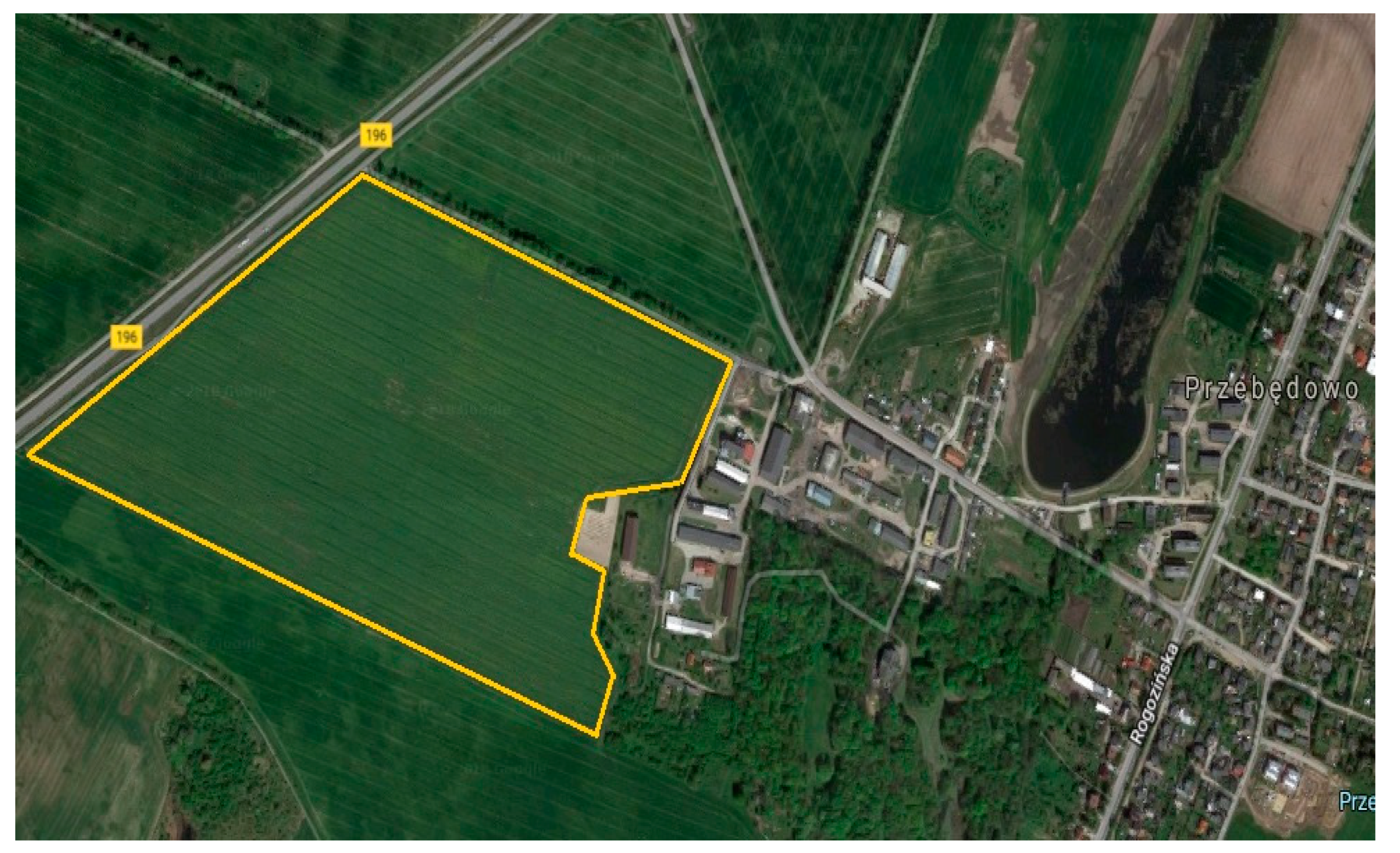
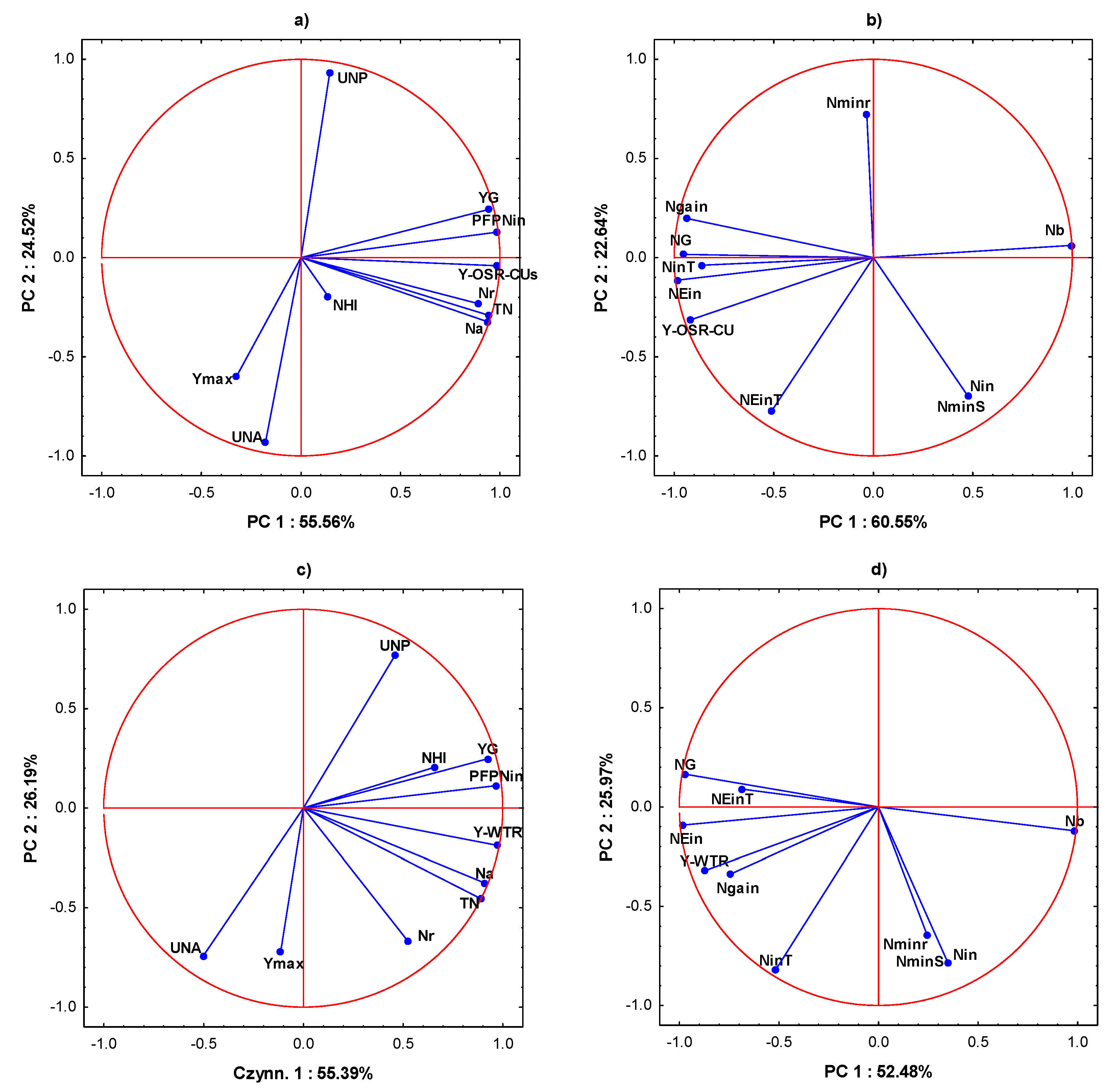
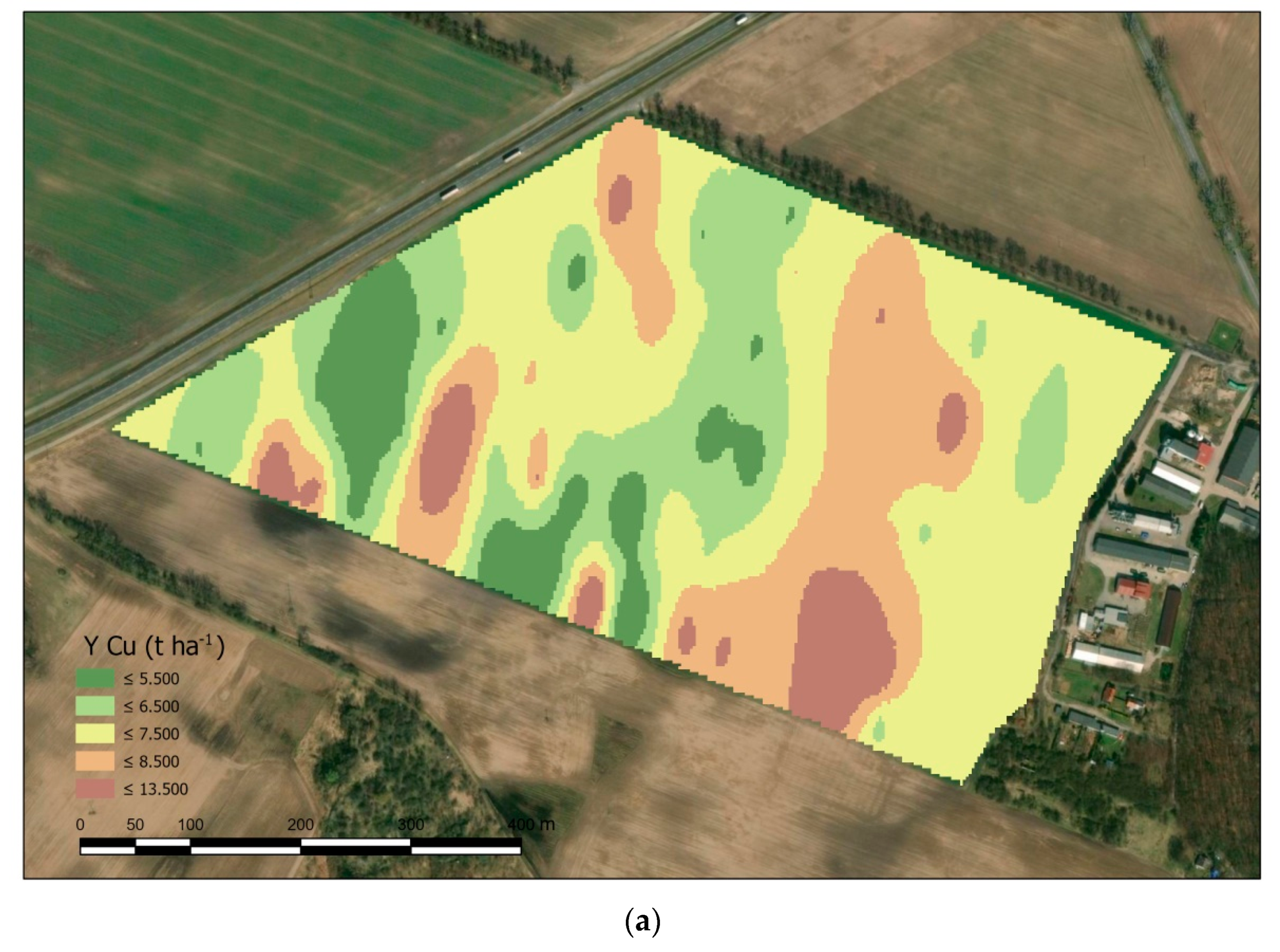
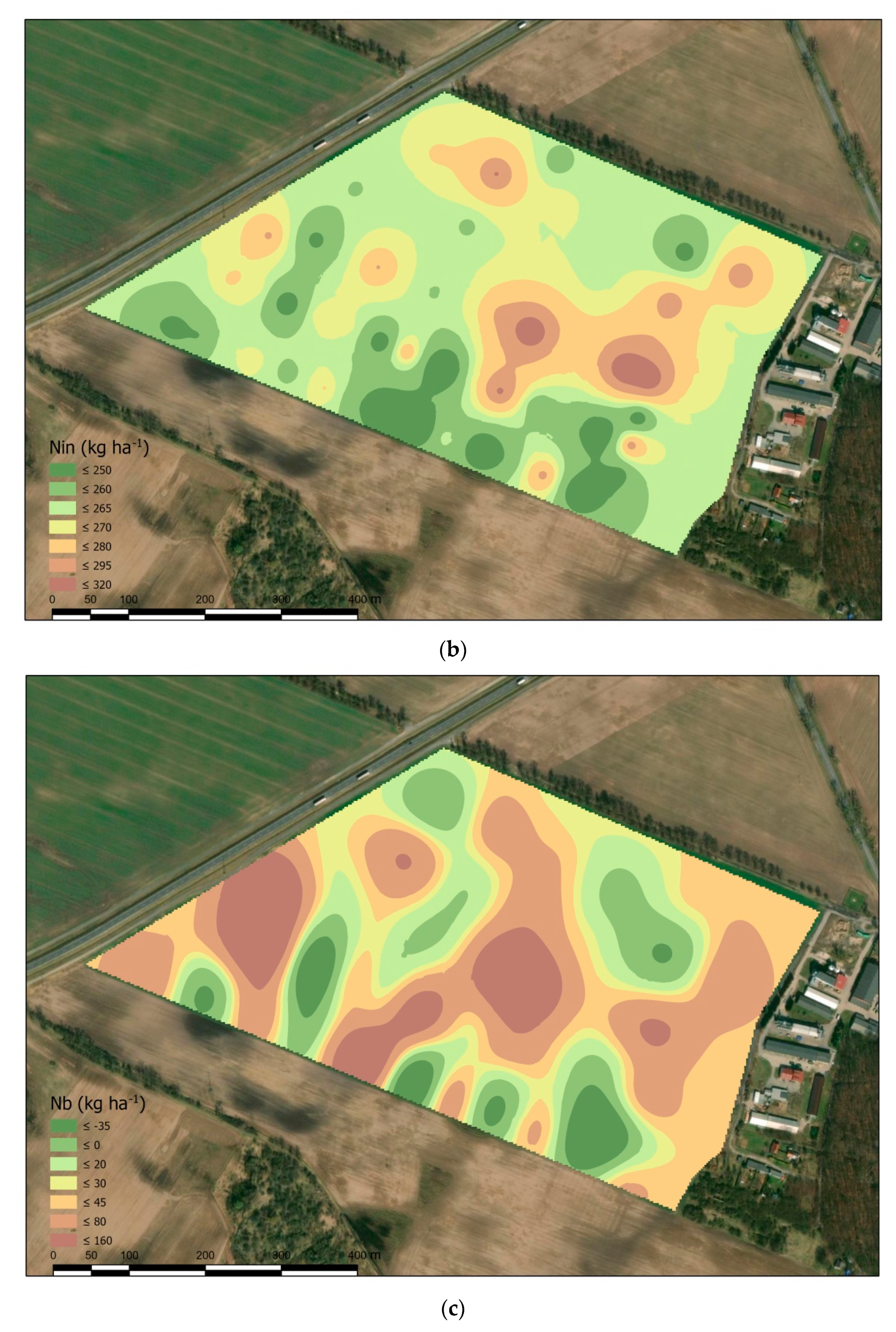
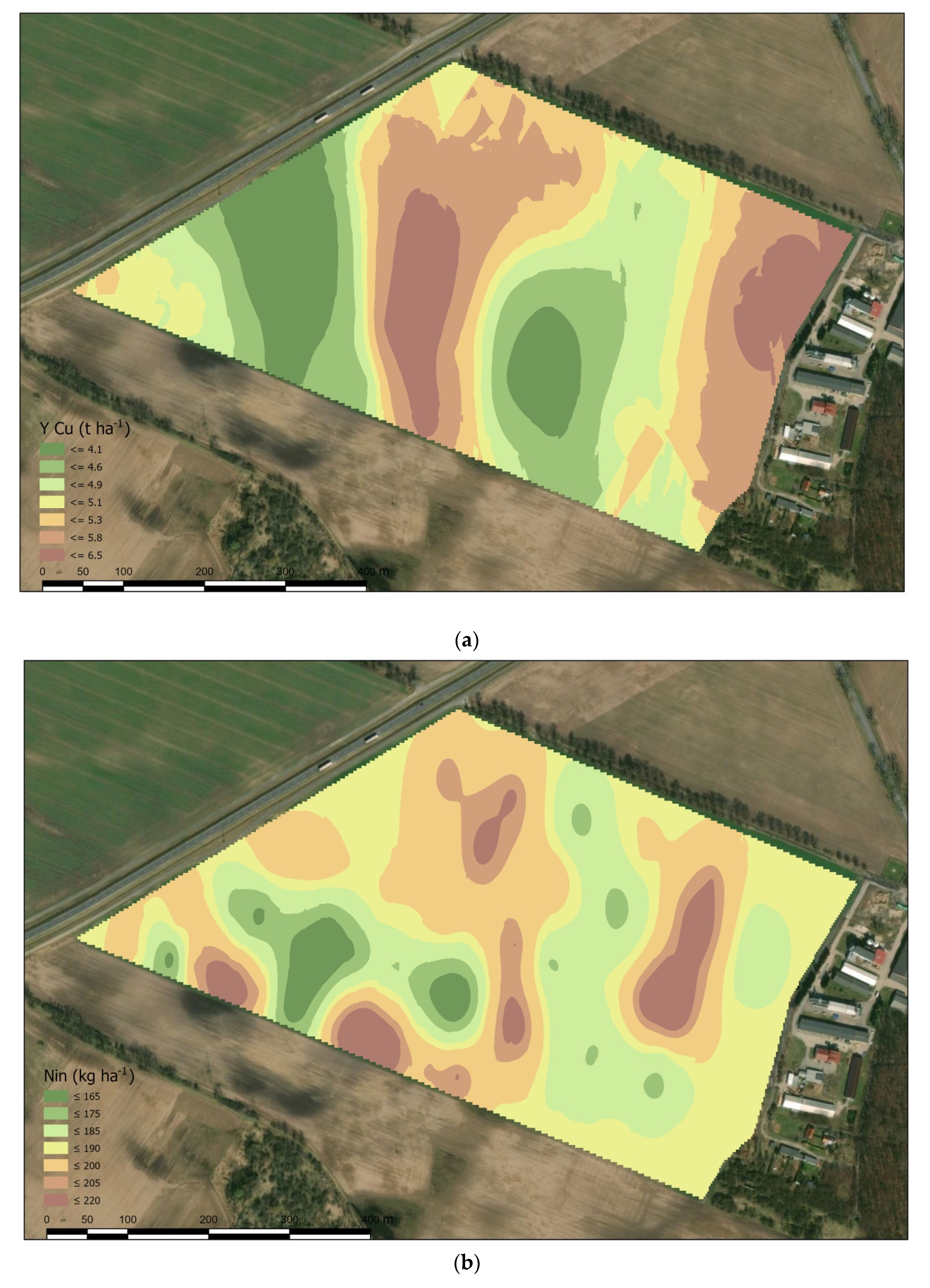
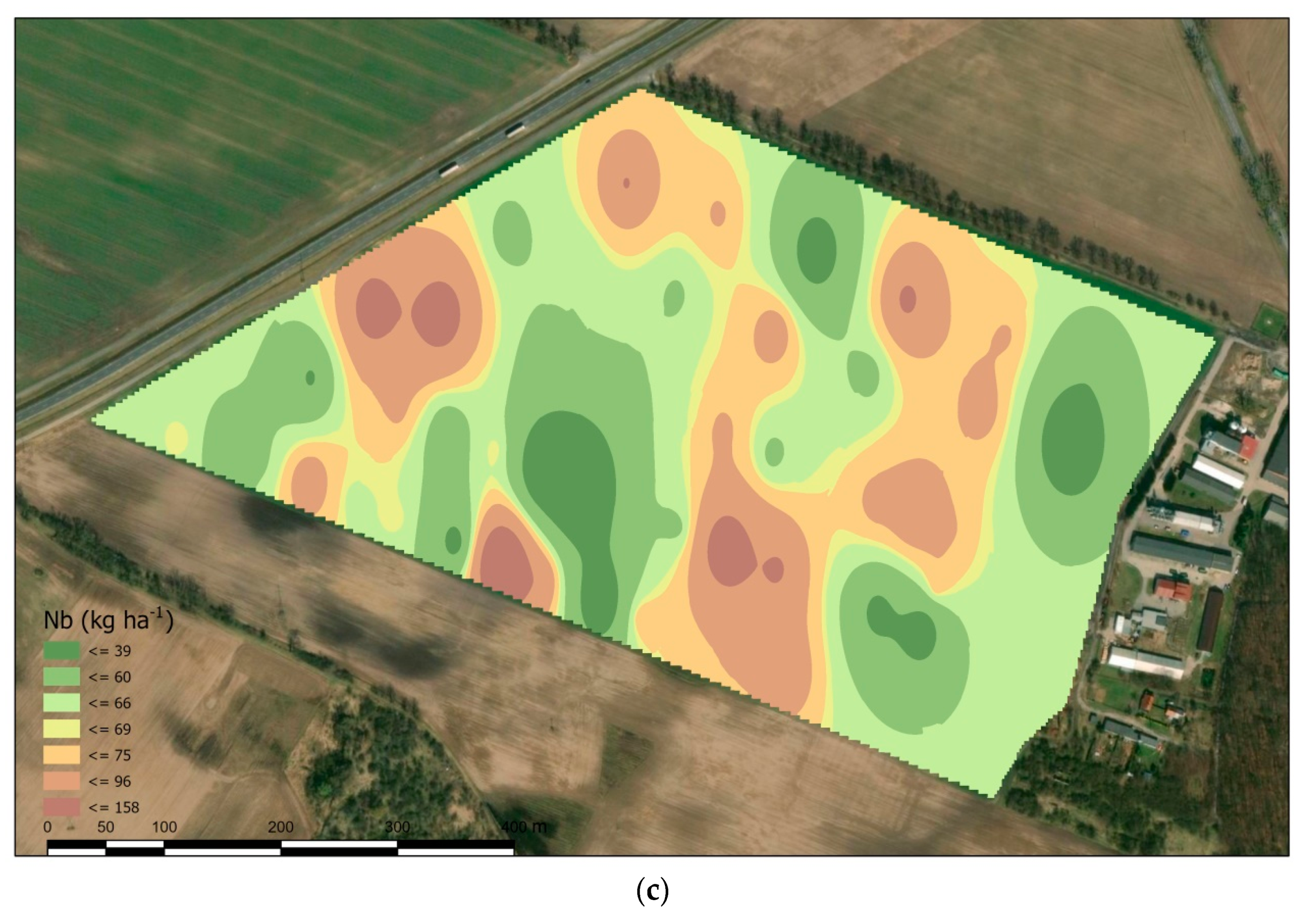
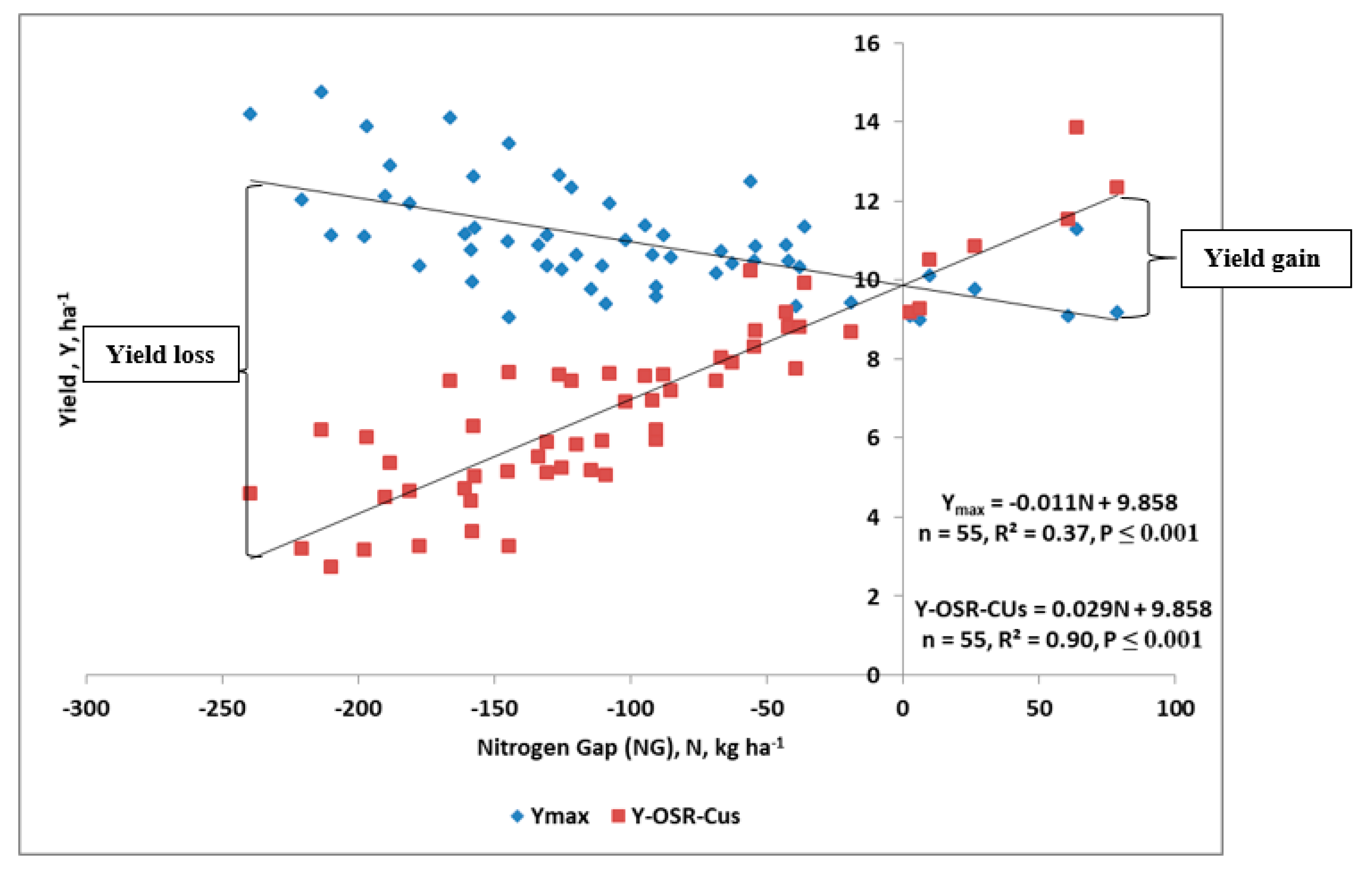
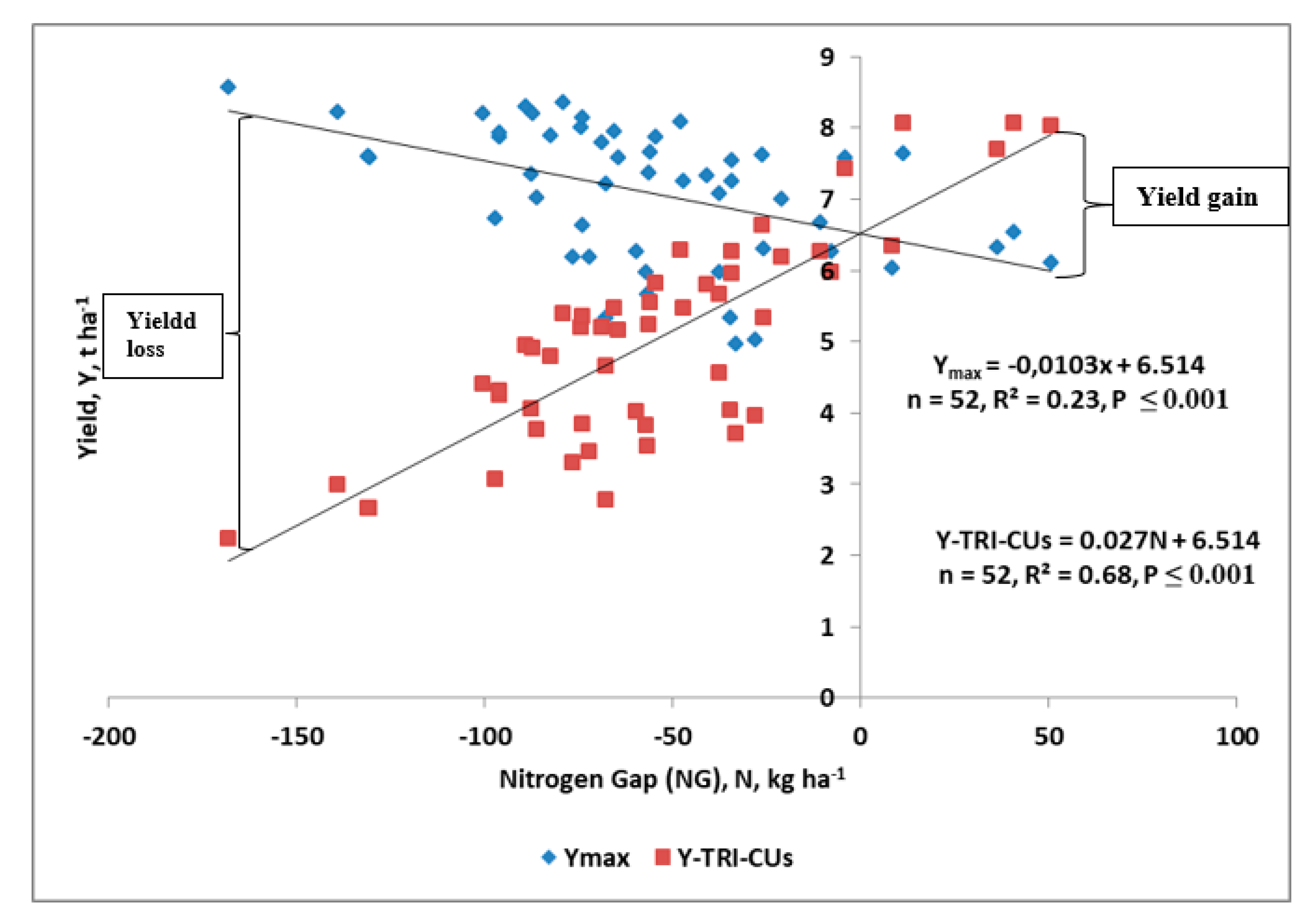
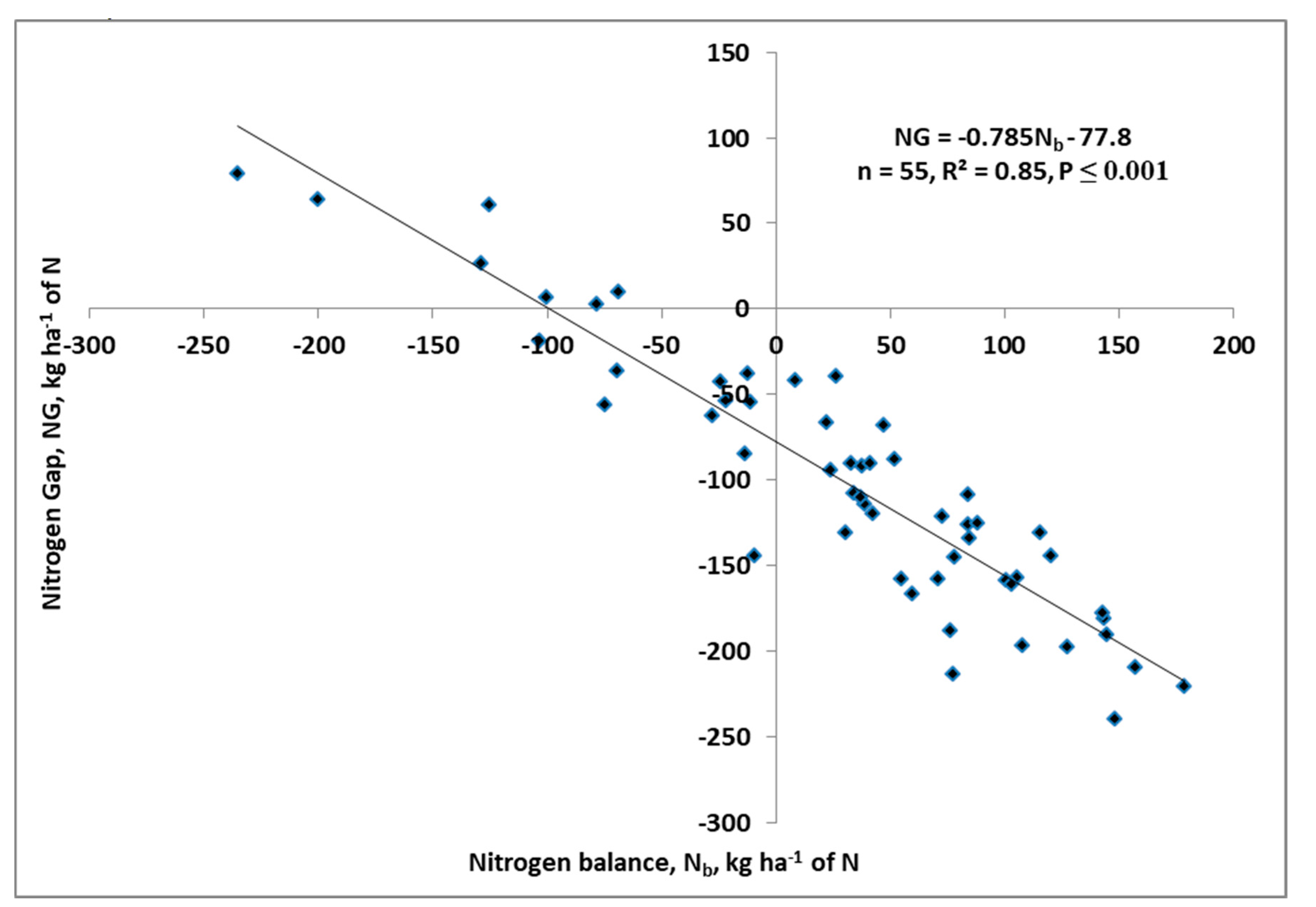
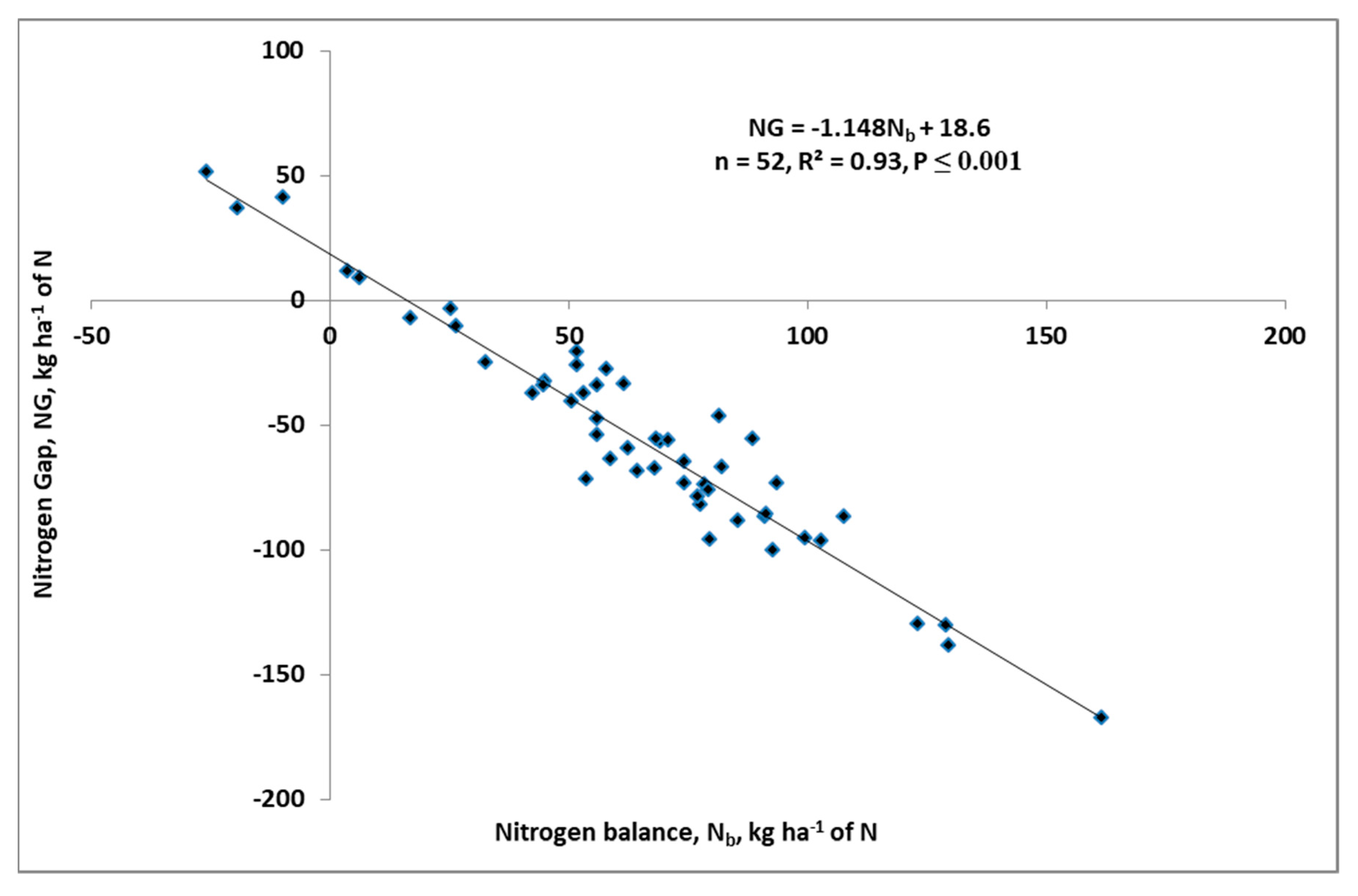
| Variables | Units | Minimum | Maximum | Mean | SD | CV,% |
|---|---|---|---|---|---|---|
| Plow layer, 0–30 cm | ||||||
| Corg 1 | % | 0.9 | 2.8 | 1.4 | 0.4 | 31.4 |
| pH, 1 M KCl 2 | - | 5.1 | 7.1 | 5.9 | 0.5 | 8.3 |
| Sand | % | 70.0 | 91.0 | 81.7 | 4.4 | 5.4 |
| silt | % | 7.0 | 26.0 | 14.6 | 3.7 | 25.2 |
| Clay | % | 1.0 | 7.0 | 3.7 | 1.5 | 40.6 |
| Rpaw 3 | mm | 36.6 | 67.7 | 51.2 | 5.9 | 11.5 |
| P 4 | mg kg−1 | 31.5 | 672 | 229 | 136 | 59.5 |
| K 4 | mg kg−1 | 122 | 445 | 254 | 81.8 | 32.2 |
| Mg 4 | mg kg−1 | 62.5 | 278 | 130 | 46.9 | 36.0 |
| Ca 4 | mg kg−1 | 39.8 | 1974 | 490 | 447 | 91.3 |
| Subsoil layer, mean for 30–90 cm | ||||||
| pH, 1 M KCl 2 | - | 4.8 | 6.9 | 5.8 | 0.5 | 8.3 |
| Sand | % | 65.0 | 94.33 | 80.4 | 7.6 | 9.4 |
| silt | % | 3.3 | 30.3 | 13.4 | 5.1 | 37.6 |
| Clay | % | 1.3 | 14.3 | 6.2 | 3.3 | 52.8 |
| Rpaw 3 | mm | 83.20 | 199.6 | 142.8 | 24.9 | 17.4 |
| P 4 | mg kg−1 | 0.8 | 261 | 52.0 | 56.1 | 108 |
| K 4 | mg kg−1 | 22.0 | 637 | 142 | 99 | 69.6 |
| Mg 4 | mg kg−1 | 34.1 | 679 | 138 | 109 | 78.8 |
| Ca 4 | mg kg−1 | 15.3 | 5248 | 495 | 844 | 171 |
| Growing Season | Consecutive Months during the Growing Season | ||||||||||||
|---|---|---|---|---|---|---|---|---|---|---|---|---|---|
| VIII | IX | X | XI | XII | I | II | III | IV | V | VI | VII | Average | |
| Temperature. °C | |||||||||||||
| 2016/2017 | 18.2 | 17.1 | 8.5 | 3.1 | 1.7 | −2.2 | 0.5 | 6.7 | 7.7 | 14.2 | 18.1 | 19.4 | 9.7 |
| 2017/2018 | 19.3 | 13.7 | 11.0 | 5.5 | 2.9 | 2.2 | −2.6 | 1.0 | 13.4 | 17.9 | 19.4 | 20.9 | 10.4 |
| 1961–2009 | 17.5 | 13.3 | 8.6 | 3.6 | 0 | −1.6 | −0.5 | 2.9 | 7.9 | 13.2 | 16.4 | 18.1 | 8.1 |
| Precipitation(mm) | |||||||||||||
| 2016/2017 | 38.6 | 7.9 | 129 | 58.6 | 58.4 | 34.7 | 38.7 | 46.5 | 62.9 | 65.7 | 108 | 217 | 866 |
| 2017/2018 | 143 | 62.6 | 123 | 64.6 | 69.9 | 67.2 | 10.6 | 41.7 | 41.7 | 10.7 | 58 | 92.8 | 786 |
| 1961–2009 | 66.7 | 48.8 | 42.0 | 45.3 | 48.4 | 40.1 | 32.6 | 40.1 | 38.1 | 56.7 | 62.7 | 77.2 | 599 |
| Variables | K–S Test, d | Mean | SD | CV,% | Median | Min | Max | Skewness | Kurtosis |
|---|---|---|---|---|---|---|---|---|---|
| Y-OSR-CUs, t ha−1 | 0.092 | 6.909 | 2.452 | 35.5 | 6.946 | 2.734 | 13.836 | 0.53 | 0.12 |
| Na, kg ha−1 | 0.091 | 127.9 | 45.9 | 35.9 | 124.1 | 55.1 | 277.9 | 0.76 | 0.92 |
| Nr, kg ha−1 | 0.092 | 105.2 | 37.9 | 36.0 | 101.1 | 44.3 | 233.6 | 0.99 | 1.63 |
| TN, kg ha−1 | 0.070 | 233.1 | 81.3 | 34.9 | 221.8 | 99.3 | 473.0 | 0.80 | 0.89 |
| NHI,% | 0.054 | 54.8 | 4.1 | 7.5 | 54.8 | 42.9 | 62.5 | −0.22 | 0.14 |
| UNA, kg Na t−1 seeds | 0.107 | 18.7 | 2.2 | 11.8 | 18.7 | 13.5 | 27.5 | 0.82 | 3.99 |
| UNP, kg seeds kg−1 Na | 0.099 | 54.3 | 6.4 | 11.8 | 53.4 | 36.4 | 74.3 | 0.59 | 1.99 |
| PFPNin, kg seeds kg−1 Nin | 0.097 | 26.5 | 10.8 | 40.7 | 24.8 | 10.1 | 55.5 | 0.80 | 0.21 |
| Yatt, t ha−1 | 0.143 | 10.993 | 1.391 | 12.7 | 10.746 | 8.991 | 14.745 | 0.85 | 0.38 |
| YG, t ha−1 | 0.076 | −4.084 | 3.030 | −74.2 | −4.416 | −9.595 | 3.163 | 0.47 | −0.24 |
| Variables | K–S Test, d | Mean | SD | CV,% | Median | Min | Max | Skewness | Kurtosis |
|---|---|---|---|---|---|---|---|---|---|
| Nmin, kg ha−1 | 0.126 | 102.0 | 31.7 | 31.1 | 98.3 | 49.1 | 181.7 | 0.66 | 0.12 |
| Nin, kg ha−1 | 0.126 | 264.0 | 31.7 | 12.0 | 260.3 | 211.1 | 343.7 | 0.66 | 0.20 |
| Nminr, kg ha−1 | 0.112 | 79.8 | 33.8 | 42.3 | 74.6 | 32.9 | 173.1 | 1.06 | 0.77 |
| Nb, kg ha−1 | 0.133 | 30.8 | 89.1 | 289.1 | 41.2 | −235.2 | 178.4 | −0.89 | 0.76 |
| Ngain, kg ha−1 | 0.114 | 49.0 | 95.5 | 195.0 | 34.9 | −121.8 | 331.9 | 0.85 | 0.62 |
| Nint, kg ha−1 | 0.118 | 313.0 | 86.3 | 27.6 | 296.2 | 169.6 | 554.1 | 0.89 | 0.68 |
| NEin,% | 0.153 | 89.8 | 35.0 | 39.0 | 83.5 | 38.8 | 205.8 | 1.12 | 1.39 |
| NEinT,% | 0.152 | 73.6 | 10.8 | 14.6 | 76.9 | 44.7 | 88.4 | −0.65 | −0.27 |
| NG, kg ha−1 | 0.76 | −102.0 | 75.7 | −74.2 | −110.3 | −239.6 | 79.0 | 0.47 | −0.24 |
| Variables | Best Fitted Model | Nugget (C0) | Sill (C0 + C1) | Parameter Range (A0, m) | Mean Correlation Distance, MCD, m | Proportion C0/(C0 + C) | Spatial Dependence |
|---|---|---|---|---|---|---|---|
| Yield | |||||||
| Y-OSR-CUs | Gaussian | 0.138 | 0.147 | 120.5 | 2 | 0.49 | Moderate |
| YG | Spherical | 0.084 | 0.195 | 159.8 | 18 | 0.41 | Moderate |
| Plant N indicators | |||||||
| Na | Spherical | 0.086 | 0.138 | 82.3 | 12 | 0.38 | Moderate |
| TN | Spherical | 0.086 | 0.126 | 86.3 | 10 | 0.41 | Moderate |
| NHI | Circular | 0.001 | 0.006 | 110.9 | 34 | 0.20 | Strong |
| PFPNin | Exponential | 0.069 | 0.104 | 86.3 | 11 | 0.40 | Moderate |
| Nb | Gaussian | 0.376 | 1.478 | 100.3 | 28 | 0.20 | Strong |
| Soil N indicators | |||||||
| Nin | Exponential | 0.277 | 1.085 | 86.3 | 24 | 0.20 | Strong |
| NG | Spherical | 0.515 | 1.168 | 120.3 | 25 | 0.31 | Moderate |
| Variables | Kriging Type | Mean Prediction Error (MPE) | Root Mean Square Error (RMSE) | Average Standard Error (ASE) | Relative RSME (%) | Mean Squared Deviance Ratio (MSDR) |
|---|---|---|---|---|---|---|
| Yield | ||||||
| Y-OSR-CUs | OK | −0.018 | 2.57 | 2.96 | 14.01 | 0.87 |
| YG | SK | 0.017 | 3.06 | 3.13 | −0.01 | 0.98 |
| Plant N indicators | ||||||
| Na | OK | −0.046 | 49.86 | 52.11 | 0.85 | 0.96 |
| TN | OK | −0.070 | 91.60 | 93.72 | 0.51 | 0.98 |
| NHI | OK | 0.004 | 4.00 | 3.83 | 1.87 | 1.04 |
| PFPNin | SK | 0.014 | 10.95 | 11.55 | 3.77 | 0.95 |
| Nb | SK | 0.047 | 112.52 | 86.61 | 4.93 | 1.30 |
| Soil N indicators | ||||||
| Nin | SK | −0.025 | 31.84 | 32.07 | 0.38 | 0.00 |
| NG | SK | 0.019 | 78.42 | 77.09 | −1.17 | 1.02 |
| Variables | K–S Test, d | Mean | SD | CV,% | Median | Min | Max | Skewness | Kurtosis |
|---|---|---|---|---|---|---|---|---|---|
| 1 Y-WTR-CUs, t ha−1 | 0.074 | 4.991 | 1.463 | 29.3 | 5.167 | 2.242 | 8.067 | 0.29 | −0.35 |
| Na, kg ha−1 | 0.100 | 95.5 | 28.9 | 30.3 | 97.3 | 42.8 | 160.7 | 0.32 | −0.51 |
| Nr, kg ha−1 | 0.079 | 28.0 | 6.4 | 22.8 | 27.2 | 14.0 | 40.2 | −0.17 | −0.60 |
| TN, kg ha−1 | 0.081 | 123.5 | 33.4 | 27.1 | 127.3 | 65.8 | 199.2 | 0.21 | −0.55 |
| NHI,% | 0.093 | 76.7 | 4.3 | 5.6 | 77.0 | 65.0 | 83.4 | −0.62 | 0.04 |
| UNA, kg Na t−1 seeds | 0.088 | 25.0 | 2.6 | 10.4 | 24.9 | 19.0 | 31.9 | 0.28 | 0.28 |
| UNP, kg seeds kg−1 Na | 0.057 | 40.4 | 4.2 | 10.5 | 40.1 | 31.4 | 52.5 | 0.40 | 0.57 |
| PFPNin, kg seeds kg−1 Nin | 0.093 | 26.9 | 8.3 | 30.8 | 25.7 | 9.9 | 49.5 | 0.64 | 0.79 |
| Yatt, t ha−1 | 0.137 | 7.087 | 0.9 | 13.4 | 7.333 | 4.955 | 8.571 | −0.56 | −0.64 |
| YG, t ha−1 | 0.077 | −2.096 | 1.7 | −79.1 | −2.145 | −6.329 | 1.916 | 0.15 | 0.63 |
| Variables | K–S Test, d | Mean | SD | CV.% | Median | Min | Max | Skewness | Kurtosis |
|---|---|---|---|---|---|---|---|---|---|
| Nmin, kg ha−1 | 0.137 | 88.1 | 25.1 | 28.5 | 94.6 | 31.5 | 127.5 | −0.56 | −0.64 |
| Nin, kg ha−1 | 0.137 | 188.1 | 25.1 | 13.4 | 194.6 | 131.5 | 227.5 | −0.56 | −0.64 |
| Nminr, kg ha−1 | 0.125 | 99.2 | 27.8 | 28.0 | 100.2 | 46.8 | 184.0 | 0.76 | 1.19 |
| Nb, kg ha−1 | 0.118 | 64.7 | 36.9 | 57.1 | 67.9 | −25.9 | 161.7 | −0.21 | 0.81 |
| Ngain, kg ha−1 | 0.086 | 34.5 | 39.7 | 114.9 | 33.0 | −55.6 | 106.4 | 0.01 | −0.28 |
| Nint, kg ha−1 | 0.074 | 222.6 | 40.4 | 18.2 | 224.3 | 139.3 | 315.7 | 0.06 | −0.03 |
| NEin,% | 0.129 | 66.2 | 18.2 | 27.6 | 64.8 | 28.9 | 116.0 | 0.73 | 0.87 |
| NEint,% | 0.086 | 55.2 | 10.0 | 18.2 | 55.6 | 34.5 | 74.8 | −0.10 | −0.76 |
| NG, kg ha−1 | 0.077 | −55.6 | 44.0 | −79.1 | −56.9 | −168.0 | 50.9 | 0.15 | 0.63 |
| Variables | Best Fitted Model | Nugget (C0) | Sill (C0 + C1) | Parameter Range, (A0), m | Mean Correlation Distance (MCD) m | Proportion C0/(C0 + C) | Spatial Distance (A0) |
|---|---|---|---|---|---|---|---|
| Yield | |||||||
| 1Y-WTR-CUs | Exponential | 0.061 | 0.120 | 120.5 | 22 | 0.34 | Moderate |
| YG | Spherical | 0.358 | 1.152 | 101.4 | 26 | 0.24 | Strong |
| Plant Nitrogen Indicators | |||||||
| Na | Exponential | 0.048 | 0.129 | 100.3 | 24 | 0.27 | Moderate |
| TN | Exponential | 0.062 | 0.090 | 134.8 | 16 | 0.41 | Moderate |
| NHI | Exponential | 0.0003 | 0.003 | 86.3 | 29 | 0.10 | Strong |
| PFPNin | Exponential | 0.038 | 0.133 | 180.5 | 49 | 0.22 | Strong |
| Nb | Spherical | 0.244 | 1.153 | 94.1 | 28 | 0.17 | Strong |
| Soil Nitrogen Indicators | |||||||
| Nin | Spherical | 0.515 | 1.123 | 98.9 | 20 | 0.31 | Moderate |
| NG | Exponential | 0.073 | 1.269 | 131.0 | 46 | 0.05 | Strong |
| Variables | Kriging Type | Mean Prediction Error (MPE) | Root Mean Square Error (RSME) | Average Standard Error (ASE) | Relative RSME (%) | Mean Squared Deviance Ratio (MSDR) |
|---|---|---|---|---|---|---|
| Yield | ||||||
| Y-WTR | OK | −0.014 | 1.41 | 1.60 | 18.21 | 0.88 |
| YG | SK | 0.005 | 1.59 | 1.67 | −0.05 | 0.95 |
| Plant nitrogen indicators | ||||||
| Na | OK | −0.003 | 28.59 | 32.66 | 0.87 | 0.88 |
| TN | OK | −0.007 | 32.26 | 34.51 | 0.68 | 0.94 |
| NHI | OK | −0.027 | 4.93 | 4.21 | 1.32 | 1.17 |
| PFPNin | OK | −0.016 | 8.12 | 8.31 | 3.35 | 0.98 |
| Nb | SK | −0.015 | 35.77 | 37.63 | 1.46 | 0.95 |
| Soil nitrogen indicators | ||||||
| Nin | SK | −0.041 | 23.27 | 25.99 | 0.48 | 0.90 |
| NG | SK | 0.010 | 42.27 | 44.27 | −1.75 | 0.95 |
Publisher’s Note: MDPI stays neutral with regard to jurisdictional claims in published maps and institutional affiliations. |
© 2020 by the authors. Licensee MDPI, Basel, Switzerland. This article is an open access article distributed under the terms and conditions of the Creative Commons Attribution (CC BY) license (http://creativecommons.org/licenses/by/4.0/).
Share and Cite
Łukowiak, R.; Grzebisz, W.; Ceglarek, J.; Podolski, A.; Kaźmierowski, C.; Piekarczyk, J. Spatial Variability of Yield and Nitrogen Indicators—A Crop Rotation Approach. Agronomy 2020, 10, 1959. https://doi.org/10.3390/agronomy10121959
Łukowiak R, Grzebisz W, Ceglarek J, Podolski A, Kaźmierowski C, Piekarczyk J. Spatial Variability of Yield and Nitrogen Indicators—A Crop Rotation Approach. Agronomy. 2020; 10(12):1959. https://doi.org/10.3390/agronomy10121959
Chicago/Turabian StyleŁukowiak, Remigiusz, Witold Grzebisz, Jakub Ceglarek, Adam Podolski, Cezary Kaźmierowski, and Jan Piekarczyk. 2020. "Spatial Variability of Yield and Nitrogen Indicators—A Crop Rotation Approach" Agronomy 10, no. 12: 1959. https://doi.org/10.3390/agronomy10121959
APA StyleŁukowiak, R., Grzebisz, W., Ceglarek, J., Podolski, A., Kaźmierowski, C., & Piekarczyk, J. (2020). Spatial Variability of Yield and Nitrogen Indicators—A Crop Rotation Approach. Agronomy, 10(12), 1959. https://doi.org/10.3390/agronomy10121959






